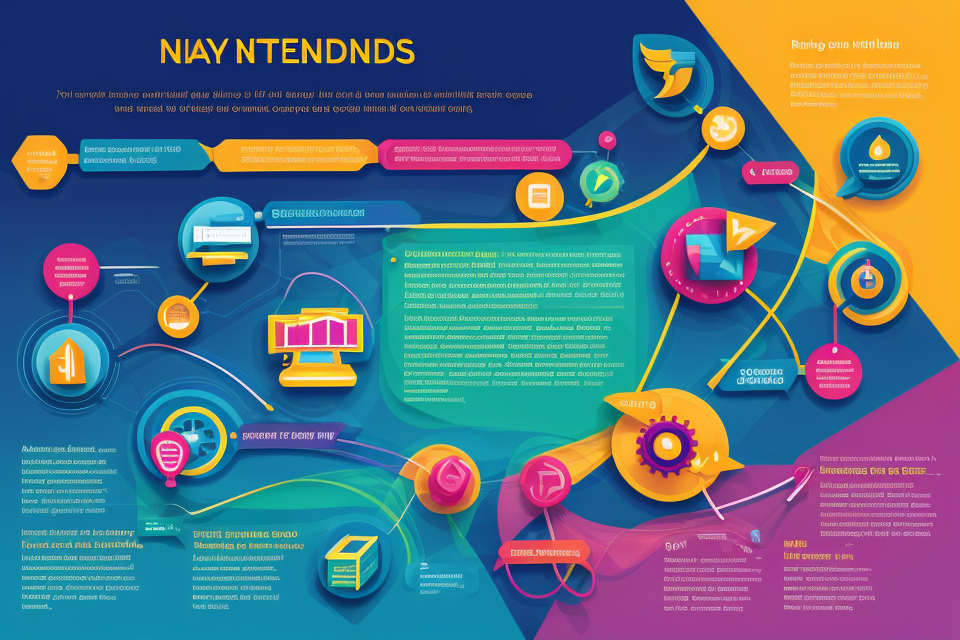Data science is a field that heavily relies on coding. Coding is the backbone of data science, and it allows data scientists to manipulate, analyze, and visualize data. With so many programming languages and frameworks available, it can be challenging to determine which one is best suited for data science. In this comprehensive guide, we will explore the most commonly used coding languages and frameworks in data science, their applications, and their pros and cons. Whether you are a beginner or an experienced data scientist, this guide will provide you with valuable insights into the world of data science coding. So, let’s dive in and explore the exciting world of data science coding!
Data science is a field that heavily relies on coding to analyze and manipulate data. There are several types of coding languages used in data science, including Python, R, SQL, and Julia. Python is a popular choice for data science due to its simplicity and extensive libraries, such as NumPy and Pandas, which provide tools for data manipulation and analysis. R is another popular language for data science, with a strong focus on statistical analysis and visualization. SQL is commonly used for data retrieval and manipulation in databases, while Julia is a newer language that offers high-level syntax and is optimized for numerical and scientific computing. Ultimately, the choice of coding language depends on the specific needs and goals of the data science project.
Programming Languages Used in Data Science
Python
Popularity and Versatility
Python is a widely popular programming language in the field of data science due to its versatility and simplicity. It is a high-level, interpreted language that is easy to learn and has a vast number of libraries and frameworks that make it suitable for data analysis, machine learning, and more.
Libraries and Frameworks for Data Science
Python has a plethora of libraries and frameworks that make it a go-to language for data science. Some of the most commonly used libraries include NumPy, Pandas, Matplotlib, Scikit-learn, TensorFlow, Keras, and more. These libraries provide tools for data manipulation, visualization, and machine learning.
NumPy is a library for numerical computing in Python. It provides support for large, multi-dimensional arrays and matrices, along with a large collection of mathematical functions to operate on these arrays.
Pandas is a library for data manipulation and analysis. It provides powerful data structures, such as DataFrames and Series, for working with structured data. Pandas also provides a variety of tools for data cleaning, filtering, and aggregation.
Matplotlib is a library for data visualization in Python. It provides a variety of plotting functions for creating static, animated, and interactive visualizations. Matplotlib is widely used for creating scatter plots, histograms, bar charts, and more.
Scikit-learn is a library for machine learning in Python. It provides a variety of algorithms for classification, regression, clustering, and more. Scikit-learn also provides tools for model selection, cross-validation, and preprocessing.
TensorFlow is a library for machine learning and deep learning in Python. It provides a variety of tools for building and training neural networks, as well as tools for distributed computing and scalable machine learning.
Keras is a high-level library for building and training neural networks in Python. It provides a simple, user-friendly interface for building and training deep learning models, and is often used in conjunction with TensorFlow.
These are just a few examples of the many libraries and frameworks available in Python for data science. With its vast collection of tools and its growing popularity, Python is an ideal language for data scientists to learn and use.
R
R is a programming language that is widely used in data science for statistical analysis and visualization. It is known for its ability to handle large datasets and perform complex calculations. Some of the libraries that are commonly used in R for data manipulation and analysis include:
- dplyr: A library for manipulating data frames and data tables. It allows users to filter, group, and summarize data, as well as perform actions such as sorting and mutating.
- ggplot2: A library for creating visualizations and graphics. It is commonly used for creating scatter plots, histograms, and other types of plots.
- lm(): A function for fitting linear models. It is used to estimate the parameters of a linear regression model and make predictions based on new data.
- summary(): A function for summarizing data. It provides a concise summary of the main features of a dataset, including measures of central tendency, dispersion, and association.
Overall, R is a powerful tool for data scientists and provides a wide range of functions and libraries for data manipulation, analysis, and visualization.
SQL
Querying and Managing Data in Databases
SQL (Structured Query Language) is a programming language used for managing and manipulating data in relational databases. It is one of the most commonly used languages in data science and is used to retrieve, manipulate, and analyze data stored in databases.
Joins, Aggregations, and Filtering
SQL provides various tools for querying data from databases. Joins are used to combine data from multiple tables based on a common column. Aggregations are used to group data and perform calculations on the groups, such as calculating the average or sum of a column. Filtering is used to select specific rows from a table based on certain conditions.
GROUP BY, HAVING, ORDER BY, and More
SQL provides a variety of clauses for grouping and sorting data. The GROUP BY clause is used to group data by one or more columns, while the HAVING clause is used to filter the groups based on a condition. The ORDER BY clause is used to sort the data based on one or more columns.
Additionally, SQL provides a variety of functions for performing calculations on data, such as COUNT, SUM, AVG, MIN, and MAX. These functions can be used to analyze and summarize data, and are commonly used in data science applications.
In summary, SQL is a powerful language for managing and manipulating data in databases, and is an essential tool for data scientists. Its versatility and flexibility make it a key component in data science workflows, from data cleaning and preparation to data analysis and visualization.
Data Science Tools and Technologies
Data Visualization
Effective communication of insights is crucial in data science, and data visualization plays a vital role in achieving this goal. It involves the use of graphical representations to display and explain data. In this section, we will explore the importance of data visualization in data science and some of the popular tools used for this purpose.
Importance of Data Visualization in Data Science
Data visualization helps data scientists to:
- Identify patterns and trends in data
- Communicate complex data insights to non-technical stakeholders
- Detect outliers and anomalies in data
- Compare and contrast different datasets
- Make informed decisions based on data insights
Popular Data Visualization Tools in Data Science
Some of the most popular data visualization tools used by data scientists include:
- Matplotlib: A Python library used for creating static, animated, and interactive visualizations in 2D and 3D. It provides a range of chart types, including line plots, scatter plots, bar charts, and histograms.
- Seaborn: A Python library built on top of Matplotlib that provides additional functionalities for statistical graphics, including heatmaps, faceted plots, and scatter plots with statistical annotations.
- Plotly: A versatile open-source JavaScript library used for creating interactive and highly customizable visualizations in web applications. It supports a wide range of chart types, including line plots, scatter plots, bar charts, and heatmaps.
- Tableau: A powerful data visualization tool used for creating interactive dashboards and reports. It provides a range of chart types, including maps, heatmaps, and scatter plots, and allows users to connect to a variety of data sources.
- Power BI: A business analytics service by Microsoft used for creating interactive and visually appealing reports and dashboards. It supports a range of chart types, including bar charts, line charts, and scatter plots, and allows users to connect to a variety of data sources.
These tools enable data scientists to create compelling visualizations that effectively communicate data insights to stakeholders. They provide a range of customization options, allowing data scientists to tailor their visualizations to specific audiences and use cases. By leveraging these tools, data scientists can make data-driven decisions and drive business value through data-informed insights.
Machine Learning
Algorithms and Models for Prediction and Classification
Machine learning (ML) is a key aspect of data science that involves training algorithms to learn from data and make predictions or classifications. There are several algorithms and models used in ML, including:
- Linear regression: a statistical method for modeling the relationship between a dependent variable and one or more independent variables.
- Logistic regression: a type of regression analysis used for classification tasks where the dependent variable is binary or dichotomous.
- Decision trees: a type of algorithm that models decisions and their possible consequences.
- Random forests: an ensemble learning method that operates by constructing multiple decision trees at training time and outputting the class that is the mode of the classes or mean prediction of the classes.
- Support vector machines (SVMs): a class of supervised learning algorithms used for classification and regression analysis.
- Neural networks: a set of algorithms that are designed to recognize patterns in data.
Supervised, Unsupervised, and Reinforcement Learning
Machine learning can be broadly categorized into three types based on the amount of labeled data available for training:
- Supervised learning: a type of ML where the model is trained on labeled data, which means that the input data has corresponding output values. Examples of supervised learning algorithms include linear regression, logistic regression, and support vector machines.
- Unsupervised learning: a type of ML where the model is trained on unlabeled data, which means that the input data does not have corresponding output values. Examples of unsupervised learning algorithms include clustering, dimensionality reduction, and anomaly detection.
- Reinforcement learning: a type of ML where the model learns by interacting with an environment and receiving feedback in the form of rewards or penalties. Examples of reinforcement learning algorithms include Q-learning and Deep Q-Networks (DQNs).
Model Evaluation and Deployment
Once a machine learning model has been trained, it is important to evaluate its performance and deploy it in a production environment. Model evaluation involves testing the model on a separate dataset to measure its accuracy and performance. This can be done using metrics such as accuracy, precision, recall, and F1 score.
Deployment involves deploying the model in a production environment where it can be used to make predictions or classifications on new data. This can be done using tools such as Flask or Docker, which allow for easy deployment and scaling of machine learning models. Additionally, cloud-based services such as Amazon Web Services (AWS) and Google Cloud Platform (GCP) provide scalable and secure environments for deploying machine learning models.
Big Data Technologies
Handling large-scale data processing and storage is a critical aspect of data science. To achieve this, big data technologies are utilized. These technologies are designed to handle large volumes of data efficiently and effectively. In this section, we will discuss some of the most commonly used big data technologies in data science.
Hadoop
Hadoop is an open-source framework that is designed to handle big data processing and storage. It is based on the MapReduce programming model, which enables the processing of large datasets in parallel across a cluster of computers. Hadoop consists of two main components: the Hadoop Distributed File System (HDFS) and the MapReduce framework. HDFS is responsible for storing and managing large datasets, while the MapReduce framework is responsible for processing these datasets in parallel.
Spark
Spark is another open-source big data processing framework that is widely used in data science. It is designed to be faster and more efficient than Hadoop MapReduce. Spark uses in-memory processing to achieve faster processing times, and it also supports a wide range of data processing tasks, including batch processing, real-time processing, and graph processing.
NoSQL databases
NoSQL databases are designed to handle large volumes of unstructured data. They are highly scalable and can handle high levels of traffic. NoSQL databases are often used in conjunction with big data technologies like Hadoop and Spark to manage and process large datasets. Some popular NoSQL databases include MongoDB, Cassandra, and Redis.
MapReduce, Spark Streaming, and Apache Flink
MapReduce, Spark Streaming, and Apache Flink are all programming models and frameworks that are used for real-time data processing. MapReduce is a programming model that is used with Hadoop to process large datasets in parallel. Spark Streaming is a programming model that is used with Spark to process real-time data streams. Apache Flink is a programming model that is used for real-time data processing and streaming. These programming models and frameworks are essential for real-time data processing and analysis in data science.
Cloud Computing
Cloud computing has become an essential tool for data scientists, providing scalable and flexible computing resources that enable them to store, process, and analyze large volumes of data. The three major cloud computing platforms for data science are Amazon Web Services (AWS), Google Cloud Platform (GCP), and Microsoft Azure. These platforms offer a range of services that are tailored to the needs of data scientists, including virtual machines, containers, and serverless computing.
One of the primary benefits of cloud computing for data science is the ability to scale resources up or down as needed. This is particularly important for data science projects that require significant computing power, as it allows data scientists to access the resources they need without having to invest in expensive hardware. Cloud computing also enables data scientists to access data from a variety of sources, including on-premises data centers, public data repositories, and private cloud environments.
Another key advantage of cloud computing for data science is the ability to use virtual machines and containers to create isolated environments for data analysis. This can help to ensure that data analysis is conducted in a secure and controlled manner, reducing the risk of data breaches or other security issues. Cloud computing also provides data scientists with a range of tools for data visualization, machine learning, and other data science tasks.
Serverless computing is a relatively new technology that is gaining popularity among data scientists. Serverless computing involves running code in response to events, rather than running code continuously in the background. This can be particularly useful for data science projects that require the processing of large volumes of data, as it allows data scientists to scale resources up or down as needed without having to worry about the underlying infrastructure.
In conclusion, cloud computing is an essential tool for data science, providing data scientists with the resources they need to store, process, and analyze large volumes of data. The flexibility and scalability of cloud computing make it an ideal solution for data science projects that require significant computing power, while the range of tools and services available on major cloud platforms such as AWS, GCP, and Azure make it easier for data scientists to complete a wide range of data science tasks.
Data Science Best Practices and Tips
Version Control
Managing code changes and collaborations is an essential aspect of data science projects. Version control systems such as Git and GitHub provide a platform for data scientists to track changes, collaborate with team members, and maintain a history of code modifications.
Git is a distributed version control system that allows multiple users to work on the same codebase simultaneously. It is widely used in the data science community due to its ability to manage large code repositories and handle complex code changes. Git provides features such as branching, merging, and pull requests, which enable collaboration and code review.
GitHub is a web-based platform that provides hosting for Git repositories. It offers additional features such as issue tracking, code review, and project management tools. GitHub allows data scientists to easily share their code with others, and it provides a platform for open-source collaboration.
In data science projects, version control is critical for maintaining code quality, tracking changes, and collaborating with team members. Git and GitHub provide a powerful platform for managing code changes and collaborations, enabling data scientists to work efficiently and effectively.
Code Reviews and Documentation
Code reviews and documentation are crucial aspects of data science that help ensure code quality and clarity. They are also important for getting feedback from peers and making the code easily accessible to others. In this section, we will discuss these two aspects in detail.
Peer Feedback and Code Commenting
Peer feedback and code commenting are essential for improving the quality of the code. Code comments should be used to explain the purpose of the code, the algorithm used, and any assumptions made. It is also important to provide feedback on the code, either through pull requests or by leaving comments directly in the code. This helps to improve the code and makes it easier for others to understand and use.
Jupyter Notebooks and README Files
Jupyter notebooks are an excellent tool for data science as they allow for the creation of interactive and shareable documents. They can be used to document the entire data science process, from data collection to model deployment. README files are also important as they provide a summary of the code and make it easier for others to understand and use. A good README file should include a brief description of the code, installation instructions, usage instructions, and any dependencies required.
Overall, code reviews and documentation are critical for ensuring the quality and accessibility of data science code. By following best practices for code reviews and documentation, data scientists can improve the quality of their code and make it easier for others to use and understand.
Data Cleaning and Preprocessing
Handling Missing Values and Outliers
- Identifying missing values: The first step in handling missing values is to identify them in the dataset. This can be done using statistical tests or by simply looking at the data.
- Handling missing values: Once the missing values have been identified, they can be handled in several ways, such as imputation, deletion, or modeling. Imputation involves filling in the missing values with a plausible value, while deletion involves removing the observations with missing values. Modeling involves building a model that can handle the missing values.
Feature Engineering and Selection
- Feature engineering: Feature engineering involves creating new features from existing ones to improve the performance of the model. This can be done using various techniques such as polynomial features, interaction terms, and log transformations.
- Feature selection: Feature selection involves selecting the most relevant features for the model. This can be done using statistical tests, correlation analysis, or feature importance scores.
Data Transformation and Normalization
- Data transformation: Data transformation involves converting the data into a different format or scale to improve the performance of the model. This can be done using techniques such as scaling, normalization, or one-hot encoding.
- Data normalization: Data normalization involves converting the data to a standard scale, such as the interval or ratio scale, to improve the performance of the model. This can be done using techniques such as min-max scaling or z-score normalization.
Model Interpretability and Ethics
Explaining and Interpreting Machine Learning Models
- Machine learning models are often complex and difficult to understand, which can lead to issues with transparency and accountability.
- Techniques such as feature importance, partial dependence plots, and variable importance can help to shed light on how the model is making its predictions.
- Explaining individual predictions can be especially important in high-stakes applications such as healthcare or finance.
Fairness, Transparency, and Ethical Considerations
- Ensuring that machine learning models are fair and unbiased is an important ethical consideration in data science.
- Different types of bias can occur in machine learning, including statistical bias, representation bias, and algorithmic bias.
- Techniques such as data cleaning, sampling, and algorithmic auditing can help to mitigate bias in machine learning models.
Lime, Shap, and Model Bias Mitigation Techniques
- LIME (Local Interpretable Model-agnostic Explanations) and SHAP (SHapley Additive exPlanations) are two popular techniques for explaining machine learning models.
- LIME works by identifying the individual features that contribute the most to a particular prediction, while SHAP computes a game-theoretic approach to attribute importance to each feature.
- Other model bias mitigation techniques include oversampling, undersampling, and data augmentation.
FAQs
1. What type of coding is used in data science?
Data science requires a combination of programming languages and tools to perform various tasks such as data cleaning, data visualization, statistical analysis, machine learning, and more. Some of the most commonly used programming languages in data science include Python, R, SQL, and SAS. Python is particularly popular due to its versatility and the availability of numerous libraries such as NumPy, Pandas, and Scikit-learn, which simplify data manipulation and analysis.
2. Is it necessary to learn multiple programming languages for data science?
While it is not strictly necessary to learn multiple programming languages for data science, it can be beneficial to do so. Different programming languages have different strengths and are better suited to different tasks. For example, Python is a general-purpose language that is well-suited to data manipulation and analysis, while R is particularly useful for statistical analysis and data visualization. Learning multiple programming languages can also help you to understand the strengths and weaknesses of different tools and choose the best one for a particular task.
3. How can I get started with coding for data science?
Getting started with coding for data science is relatively easy, especially if you have some basic programming skills. One of the most popular programming languages for data science is Python, which has a large and active community that provides many resources for beginners. There are also many online courses and tutorials available that can help you to learn the basics of Python and data science. Some useful resources include Codecademy, Coursera, and edX. Additionally, there are many open-source datasets available that you can use to practice your coding skills and build your own data science projects.
4. What are some of the most popular libraries for data science in Python?
Python has a number of popular libraries that are commonly used in data science, including NumPy, Pandas, and Scikit-learn. NumPy is a library for working with large, multi-dimensional arrays and matrices, while Pandas is a library for data manipulation and analysis. Scikit-learn is a library for machine learning, which includes a wide range of algorithms for tasks such as classification, regression, clustering, and more. Other popular libraries for data science in Python include Matplotlib for data visualization, BeautifulSoup for web scraping, and TensorFlow for deep learning.
5. Can I use R for data science?
Yes, R is a popular programming language for data science, particularly for statistical analysis and data visualization. R has a number of powerful libraries for data manipulation and analysis, including dplyr, ggplot2, and tidyr. R is also particularly well-suited to working with statistical models and performing hypothesis testing. While Python is generally considered to be more versatile and easier to learn, R has a large and active community and is a popular choice for data scientists who specialize in statistical analysis.



